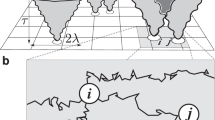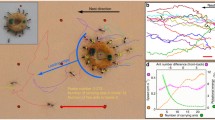Abstract
Self-organised collective decision making is one of the core components of swarm intelligence, and numerous swarm algorithms that are widely used in optimisation and optimal control have been inspired by the biological mechanisms driving it. Beyond the life sciences and bio-inspired engineering, collective decision making is important in a number of other disciplines, most prominently economics and the social sciences. A paradigmatic model system for collective decision making is the foraging behaviour of mass recruiting ant colonies. While this system has been investigated extensively, our knowledge about its function in dynamic environments is still incomplete at best. We show that the mathematical model of mass foraging is really just a specific instance of a very general class of rational group decision making processes. We analyse this general class using an information-theoretic framework, which allows us to abstract from the specific details of a fixed model system. We specifically investigate how noisy communication can enable groups to share information about changes in an environment more efficiently. In the present paper, we show that an optimal noise level exists and that this optimal level depends on the rate of change in the environment. We explain this on the basis of stochastic resonance theory and show why stochastic attractor switching is a suitable base mechanism for adaptive group decision making in dynamic environments.











Similar content being viewed by others
Notes
This is true for purely mass foraging species (Hölldobler and Wilson 1990).
Note that this figure gives the exact plot of a double-well potential function U that we will be defining later in Sect. 4.4.1 and Eq. 19. Here the only property of U that matters is that it is a double-well potential. The exact shape of the potential and thus the parameter values are not relevant at the present point.
There are of course also other channels of communication, for example trophallaxis, but we focus the discussion on pheromone communication here.
Since actual movements have no impact on the simulation outcomes they are not explicitly modelled.
All calculations were performed using numerical integration in Mathematica 11.0 with parameters WorkingPrecision = 16, AccuracyGoal = 2, Method = {GlobalAdaptive, MaxErrorIncreases = 10000}.
For a critical discussion of this claim see Pfeifer (2006).
The sole exception is the approximation by adiabatic elimination, which is entirely dispensable in our approach, as we can rely on EFA instead.
References
Armitage, J. (1999). Bacterial tactic responses. Advances in Microbial Physiology, 41, 229–289.
Axelrod, R. (1997). The complexity of cooperation: Agent-based models of competition and collaboration. Princeton: Princeton University Press.
Beckers, R., Deneubourg, J., & Goss, S. (1993). Modulation of trail laying in the ant Lasius niger and its role in the collective selection of a food source. Journal of Insect Behaviour, 6, 751–759.
Ben-Jacob, E., Cohen, I., & Levine, H. (2000). Cooperative self-organization of microorganisms. Advances in Physics, 49(4), 395–554.
Blum, C. (2005). Ant colony optimization: Introduction and recent trends. Physics of Life Reviews, 24(4), 353–373.
Bonabeau, E., Theraulaz, G., & Dorigo, M. (1999). Swarm intelligence: From natural to artificial systems. New York: Oxford University Press.
Brambilla, M., Ferrante, E., Birattari, M., & Dorigo, M. (2013). Swarm robotics: A review from the swarm engineering perspective. Swarm Intelligence, 7, 1–41.
Britton, N., Franks, N., Pratt, S., & Seeley, T. (2002). Deciding on a new home: How do honeybees agree? Proceedings of the Royal Society of London Series B, 269, 1382–1388. doi:10.1098/rspb.2002.2001.
Camazine, S., Deneubourg, J., Franks, N. R., Sneyd, J., Theraulaz, G., & Bonabeau, E. (2001). Self-organization in biological systems. Princeton: Princeton University Press.
Capasso, V., & Bakstein, D. (2005). An introduction to continuous-time stochastic processes. Basel: Birkhäuser.
Collins, J. (1999). Fishing for function in noise. Nature, 402, 241–242.
Collins, J., Chow, C., Capela, A., & Imhoff, T. (1996). Aperiodic stochastic resonance. Physical Review E, 54(5), 5575–5584.
Corell, N. (2008). Social control of herd animals by integration of artificially controlled congeners. LNAI, 5040, 437–446.
Cover, T., & Thomas, J. A. (2006). Elements of information theory. Hoboken: Wiley.
Czaczkes, T., Grüter, C., Jones, S., & Ratnieks, F. (2011). Synergy between social and private information increases foraging efficiency in ants. Biology Letters. Published online before print February 16, 2011. doi:10.1098/rsbl.2011.0067.
Detrain, C., & Deneubourg, J. (2006). Self-organized structures in a superorganism: Do ants behave like molecules? Physics of Life Reviews, 3, 162–187.
Dorigo, M., Birattari, M., & Brambilla, M. (2014). Swarm robotics. Scholarpedia, 9(1), 1463.
Dressler, F. (2007). Self-organization in sensor and actor networks. Hoboken: Wiley.
Dussutour, A., Beekman, M., Nicolis, S. C., & Meyer, B. (2009). Noise improves collective decision-making by ants in dynamic environments. Proceedings of the Royal Society London B, 276, 4353–4361. doi:10.1098/rspb.2009.1235.
Edelstein-Keshet, L., Watmough, J., & Ermentrout, G. (1995). Trail following in ants: Individual properties determine population behaviour. Behavioral Ecology and Sociobiology, 36, 119–133.
Fewell, J. (2003). Social insect networks. Science, 301, 1867–1870.
Gammaitoni, L., Hänggi, P., Jung, P., & Marchesoni, F. (1998). Stochastic resonance. Reviews of Modern Physics, 70(1), 223–287.
Gardiner, C. (2004). Handbook of stochastic methods (3rd ed.). Berlin: Springer.
Garnier, S., Gautrais, J., & Theraulaz, G. (2007). The biological principles of swarm intelligence. Swarm Intelligence, 1, 3–31.
Gillespie, D. (1992). Markov processes: An introduction for physical scientists. Cambridge: Academic.
Haken, H. (2006). Information and self-organization–A macroscopic approach to complex systems. Berlin: Springer.
Helbing, D., Buzna, L., Johansson, A., & Werner, T. (2005). Self-organized pedestrian crowd dynamics. Transportation Science, 39(1), 1–24.
Heneghan, C., Chow, C., Collins, J., Imhoff, T., Lowen, S., & Teich, M. (1996). Information measures quantifying aperiodic stochastic resonance. Physical Review E, 54(3), 2228–2231.
Hölldobler, B., & Wilson, E. (1990). The ants. Cambridge: Harvard University Press.
Jaynes, E. (1963). Information theory and statistical mechanics. In K. Ford (Ed.), Statistical physics. Amsterdam: Benjamin.
Longtin, A. (1993). Stochastic resonance in neuron models. Journal of Statistical Physics, 70(1/2), 309–327.
Meyer, B. (2008). On the deterministic convergence dynamics of ant colony search. Complexity International, 12, 1–15. msid05.
Meyer, B., Ansorge, C., & Nakagaki, T. (2017). The role of noise in self-organized decision making by the true slime mold Physarum polycephalum. PLoS ONE, 12(3), e0172933.
Moss, F., Ward, L., & Sannita, W. G. (2004). Stochastic resonance and sensory information processing. Clinical Neurophysiology, 115(2), 267–281.
Nadal, J., Weisbuch, G., Chenevez, O., & Kirman, A. (1998). A formal approach to market organization: Choice functions, mean field approximation and maximum entropy principle. In J. Lesourne & A. Orlean (Eds.), Advances in selforganization and evolutionary economics (pp. 149–159). Paris: Economica.
Nakagaki, T., Iima, M., Ueda, T., Nishiura, Y., Saigusa, T., Tero, A., et al. (2007). Minimum-risk path finding by an adaptive amoebal network. Physical Review Letters, 99, 068104.
Nakagaki, T., Yamada, H., & Toth, A. (2000). Maze-solving by an amoeboid organism. Nature, 407, 470.
Neiman, A., Shulgin, B., Anishchenko, V., Ebeling, W., Schimansky-Geier, L., & Freund, J. (1996). Dynamical entropies applied to stochastic resonance. Physical Review Letters, 76(23), 4299–4302.
Nicolis, S. (2004). Fluctuation-induced symmetry breaking in a bistable system: A generic mechanism of selection between competing options. International Journal of Bifurcation and Chaos, 14(7), 2399–2405.
Nicolis, S., & Deneubourg, J. (1999). Emerging patterns and food recruitment in ants: An analytical study. Journal of Theoretical Biology, 198, 575–592.
Okubo, A. (1986). Dynamical aspects of animal grouping: Swarms, flocks and herds. Advances in Biophysics, 22, 1–94.
Pfeifer, J. (2006). The use of information theory in biology. Biological Theory, 1(3), 317–330.
Pratt, S., Mallon, E., Sumpter, D., & Franks, N. (2002). Quorum sensing, recruitment, and collective decision-making during colony emigration by the ant leptothorax albipennis. Behavioral Ecology and Sociobiology, 52, 117–127. doi:10.1007/s00265-002-0487-x.
Risken, H. (1989). The Fokker–Planck equation. Berlin: Springer.
Shannon, C. (1948). A mathematical theory of communication. The Bell System Technical Journal, 27, 379-423–623-656.
Sole, R., & Miramontes, O. (1995). Information at the edge of chaos in fluid neural networks. Physica D, 80(1–2), 171–180.
Strogatz, S. H. (1994). Nonlinear dynamics and chaos. Boulder: Westview Press.
Sumpter, D. (2010). Collective animal behavior. Princeton: Princeton University Press.
Tero, A., Kobayashi, R., & Nakagaki, T. (2007). A mathematical model for adaptive transport network in path finding by true slime mold. Journal of Theoretical Biology, 244, 553–564.
Tindall, M., Porter, S., Maini, P., Gaglia, G., & Armitage, J. (2008). Overview of mathematical approaches used to model bacterial chemotaxis ii: Bacterial populations. Bulletin of Mathematical Biology, 70(6), 1570–1607.
Tomforde, S., Prothmann, H., Rochner, F., Branke, J., Hähner, J., Müller-Schloer, C., & Schmeck, H. (2008). Decentralised progressive signal systems for organic traffic control. In Proceedings of the 2008 second IEEE international conference on self-adaptive and self-organizing systems, pp. 413–422, Venice: IEEE Press.
Vicsek, T. (2001). A question of scale. Nature, 411, 421.
Vigelius, M., Meyer, B., & Pascoe, G. (2014). Multiscale modelling and analysis of collective decision making in swarm robotics—The case of majority voting. PLoS ONE, 11(9), e111542.
Weisbuch, G., Kirman, A., & Herreiner, D. (2000). Market organisation and trading relationships. The Economic Journal, 110, 411–436. doi:10.1111/1468-0297.00531.
Weisbuch, G., & Stauffer, D. (2000). Hits and flops dynamics. Physica A, 287, 563–576.
Wiesenfeld, K., & Moss, F. (1995). Stochastic resonance and the benefits of noise: From ice ages to crayfish and squids. Nature, 373, 33–36.
Williams, P., & Beer, R. (2010). Information dynamics of evolved agents. In From animals to animats , (SAB 2010), Vol. 11, pp. 38–49. Paris: Springer.
Wilson, E. (1962). Chemical communication among workers of the fire ant Solenopsis saevissima (Fr. Smith): 2. An information analysis of the odour trail. Animal Behavior, 10, 148–158.
Yates, C., Erban, R., Escuderoc, C., Couzin, I., Buhle, J., Kevrekidis, I., et al. (2009). Inherent noise can facilitate coherence in collective swarm motion. Proceedings of the National Academy of Science, 106, 5464–5469.
Acknowledgements
This work was supported by the Australian Research Council under DP0879239 and DP110101413.
Author information
Authors and Affiliations
Corresponding author
Electronic supplementary material
Below is the link to the electronic supplementary material.
Rights and permissions
About this article
Cite this article
Meyer, B. Optimal information transfer and stochastic resonance in collective decision making. Swarm Intell 11, 131–154 (2017). https://doi.org/10.1007/s11721-017-0136-7
Received:
Accepted:
Published:
Issue Date:
DOI: https://doi.org/10.1007/s11721-017-0136-7




